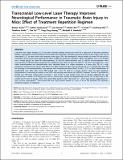Transcranial Low-Level Laser Therapy Improves Neurological Performance in Traumatic Brain Injury in Mice: Effect of Treatment Repetition Regimen
Author(s)
Xuan, Weijun; Vatansever, Fatma; Huang, Liyi; Wu, Qiuhe; Xuan, Yi; Dai, Tianhong; Ando, Takahiro; Xu, Tao; Huang, Ying-Ying; Hamblin, Michael R.; ... Show more Show less
DownloadXuan-2013-Transcranial Low-Lev.pdf (638.8Kb)
PUBLISHER_CC
Publisher with Creative Commons License
Creative Commons Attribution
Terms of use
Metadata
Show full item recordAbstract
Low-level laser (light) therapy (LLLT) has been clinically applied around the world for a spectrum of disorders requiring healing, regeneration and prevention of tissue death. One area that is attracting growing interest in this scope is the use of transcranial LLLT to treat stroke and traumatic brain injury (TBI). We developed a mouse model of severe TBI induced by controlled cortical impact and explored the effect of different treatment schedules. Adult male BALB/c mice were divided into 3 broad groups (a) sham-TBI sham-treatment, (b) real-TBI sham-treatment, and (c) real-TBI active-treatment. Mice received active-treatment (transcranial LLLT by continuous wave 810 nm laser, 25 mW/cm[superscript 2], 18 J/cm[superscript 2], spot diameter 1 cm) while sham-treatment was immobilization only, delivered either as a single treatment at 4 hours post TBI, as 3 daily treatments commencing at 4 hours post TBI or as 14 daily treatments. Mice were sacrificed at 0, 4, 7, 14 and 28 days post-TBI for histology or histomorphometry, and injected with bromodeoxyuridine (BrdU) at days 21–27 to allow identification of proliferating cells. Mice with severe TBI treated with 1-laser Tx (and to a greater extent 3-laser Tx) had significant improvements in neurological severity score (NSS), and wire-grip and motion test (WGMT). However 14-laser Tx provided no benefit over TBI-sham control. Mice receiving 1- and 3-laser Tx had smaller lesion size at 28-days (although the size increased over 4 weeks in all TBI-groups) and less Fluoro-Jade staining for degenerating neurons (at 14 days) than in TBI control and 14-laser Tx groups. There were more BrdU-positive cells in the lesion in 1- and 3-laser groups suggesting LLLT may increase neurogenesis. Transcranial NIR laser may provide benefit in cases of acute TBI provided the optimum treatment regimen is employed.
Date issued
2013-01Department
Harvard University--MIT Division of Health Sciences and TechnologyJournal
PLoS ONE
Publisher
Public Library of Science
Citation
Xuan, Weijun et al. “Transcranial Low-Level Laser Therapy Improves Neurological Performance in Traumatic Brain Injury in Mice: Effect of Treatment Repetition Regimen.” Ed. Cesar V. Borlongan. PLoS ONE 8.1 (2013).
Version: Final published version
ISSN
1932-6203